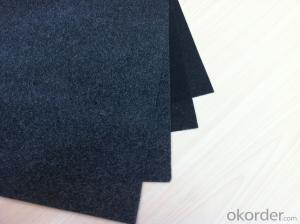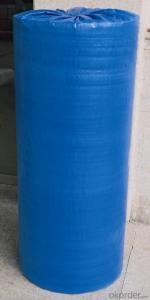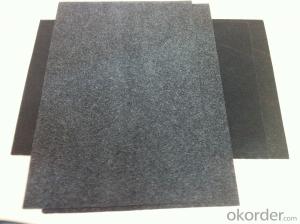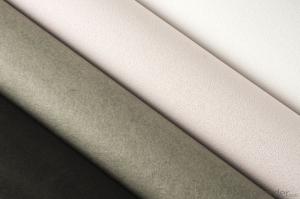C-Class Black Fiberglass Facing Tissue for Insulation-65C
- Loading Port:
- Shanghai
- Payment Terms:
- TT OR LC
- Min Order Qty:
- 500 m²
- Supply Capability:
- 100000 m²/month
OKorder Service Pledge
OKorder Financial Service
You Might Also Like
Description of Fiberglass Tissue for Thermal Insulation
Fiberglass Tissue is a kind of facing, which is made of by the white fiberglass tissue, and special production process.
Good Aspect of Fiberglass Tissue for Thermal Insulation
Light weight
• Good visual effect
• High reflective insulation
Packing of Fiberglass Tissue for Thermal Insulation
1. Waterproof paper then PVC shrinking Film
2. Water-Proof film only
3. Heat resistant, water proof, stable at high temperature;
4.Environmentally friendly, no smell and not-toxic;
5.Smooth and clear surface;
Specification of Fiberglass Tissue for Thermal Insulation
PROPERTIES | UNIT | VALUE | TEST METHOD |
Basic weight | gsm | 98 | ASTM D646 |
Tensile strength: M. D. X. D. | N/25mm | 132 65 | ASTM D828 |
Burst strength | N | 30 | ASTM D774 |
Reflectivity of foil surface | % | 95 | ---------- |
Temp. Resistance | -29°C 66°C | No Delamination No Delamination | ASTM C1263 |
Water vapor permeance | ng/N.s | 1.15 | ASTM E-96 |
Pictures of Fiberglass Tissue for Thermal Insulation




FAQ
We have organized several common questions for our clients,may help you sincerely:
1. What is the storage condition?
The Aluminum Foil Facing should be stored at room temperature and kept from wet and heat source.
2. How to guarantee the quality of the products?
We have established the international advanced quality management system,every link from raw material to final product we have strict quality test;We resolutely put an end to unqualified products flowing into the market. At the same time, we will provide necessary follow-up service assurance.
3. How long can we receive the product after purchase?
We resolutely put an end to unqualified products flowing into the market. At the same time, we will provide necessary follow-up service assurance.
- Q: Is it possible to utilize black fiberglass tissue for crafting decorative items?
- <p>Yes, black fiberglass tissue can be used to create decorative elements. It is known for its strength, durability, and flexibility, making it an ideal material for various artistic and design applications. Fiberglass can be molded into different shapes and forms, and its black color can add a sleek, modern touch to any decor. It's often used in combination with other materials to create unique and eye-catching designs, from wall art to furniture accents. However, it's important to handle fiberglass with care due to its potential health risks and to ensure proper ventilation during any cutting or shaping processes.</p>
- Q: The user is inquiring if black fiberglass tissues can be used to clean hardwood floors without causing any damage.
- <p>Yes, you can use black fiberglass tissues to clean your hardwood floors without damaging them. These tissues are designed to be gentle on surfaces and effective at picking up dust and dirt. However, it's important to ensure that the tissues are not abrasive and that they do not contain any chemicals that could harm the finish of your hardwood floors. Always test a small, inconspicuous area first to make sure there is no adverse reaction. Additionally, avoid using any excessive moisture, as this can also damage the wood. Regular sweeping or vacuuming with a soft brush attachment is recommended for routine cleaning of hardwood floors.</p>
- Q: Is it possible to use black fiberglass tissue as a material for flooring?
- <p>Yes, black fiberglass tissue can be used for flooring. It is often used in commercial and industrial settings due to its durability, resistance to chemicals, and ability to withstand heavy traffic. Fiberglass tissue is a type of composite material that can be combined with resins to create a strong and stable flooring surface. However, it is important to ensure that the fiberglass tissue is properly treated and combined with the right resins to avoid any health or safety concerns.</p>
- Q: Is it possible to utilize black fiberglass tissue in industrial applications?
- <p>Yes, black fiberglass tissue can be used for industrial purposes. It is known for its strength, durability, and resistance to various environmental conditions. Commonly used in construction, automotive, aerospace, and electrical industries, black fiberglass is valued for its non-conductive properties and ability to withstand high temperatures. It is often employed in the manufacturing of composite materials, insulation, and structural components where its unique properties are beneficial.</p>
- Q: This question asks for guidance on selecting a dependable supplier for black fiberglass tissues, a material used in various industries.
- <p>To choose a reliable supplier of black fiberglass tissues, consider the following: Check their industry reputation and customer reviews. Ensure they have the necessary certifications and quality control measures in place. Evaluate their product quality by requesting samples. Assess their delivery times and reliability. Consider the supplier's financial stability and history. Look for a supplier that offers good customer service and after-sales support. It's also important to compare prices and negotiate terms that fit your budget and requirements.</p>
- Q: This question asks for a comparison between black fiberglass tissue and other building materials, focusing on their properties and uses in construction.
- <p>Black fiberglass tissue is a unique building material known for its lightweight, high strength, and excellent resistance to corrosion and fire. Compared to traditional materials like wood or metal, it offers superior insulation properties, making it ideal for energy-efficient construction. Unlike organic materials, it doesn't rot or decay, and it's non-conductive, reducing the risk of electrical fires. It's also more resistant to harsh weather conditions and pests. However, it may be more expensive than some alternatives and requires specific knowledge for installation. Overall, while black fiberglass tissue has distinct advantages, the choice of building material depends on the specific requirements of the project, including cost, durability, and environmental impact.</p>
- Q: This question asks for a comparison of the benefits and drawbacks associated with the use of black fiberglass tissue.
- <p>The advantages of using black fiberglass tissue include its high strength-to-weight ratio, making it ideal for applications requiring durability and light weight. It offers excellent resistance to chemicals, moisture, and UV radiation, which is beneficial for outdoor applications. Additionally, black fiberglass tissue can provide a non-reflective surface, which is useful in certain industrial and aesthetic contexts. Disadvantages include its potential for skin irritation and respiratory issues if not handled properly due to the fine fibers. It can also be more expensive than some alternatives and may require special disposal methods due to its non-biodegradable nature. Furthermore, the black color may not be suitable for applications where visibility or a specific color scheme is required.</p>
- Q: Is it safe to use black fiberglass tissue in a kitchen environment, considering factors such as heat, moisture, and potential health risks?
- <p>Black fiberglass tissue is generally not recommended for use in a kitchen environment due to its potential to release glass fibers, which can be harmful if inhaled or ingested. Kitchens have high heat and moisture levels, which can degrade the fiberglass, leading to the release of these fibers. Additionally, the black color may not be suitable for surfaces that come into contact with food. It's safer to use materials specifically designed for kitchen use that are heat and moisture resistant and do not pose health risks.</p>
- Q: This question asks about the environmental consequences associated with the use of black fiberglass tissue in construction projects.
- <p>The environmental impacts of using black fiberglass tissue in construction include potential health risks due to the release of glass fibers, which can cause respiratory issues. It may also contribute to landfill waste if not recycled properly. Additionally, the manufacturing process of fiberglass can consume significant energy and produce greenhouse gases, contributing to climate change. However, it's important to note that black fiberglass tissue can also have benefits such as insulation properties that reduce energy consumption in buildings, potentially offsetting some of the environmental impacts.</p>
- Q: What are the methods to avoid entanglement of glass fiber paper during its application?
- <p>To prevent glass fiber paper from getting tangled during use, ensure proper storage in a dry, cool place away from direct sunlight. Use gloves to handle the paper to avoid skin oils that can cause sticking. Apply a light coating of talcum powder or a similar anti-static agent to reduce static electricity, which often contributes to tangling. Cut the paper with sharp, clean tools to minimize fraying. When using, unroll or unfold the paper slowly and carefully to prevent it from bunching up. Regularly clean and maintain the machinery or equipment used with the glass fiber paper to prevent buildup that could cause entanglement.</p>
Send your message to us
C-Class Black Fiberglass Facing Tissue for Insulation-65C
- Loading Port:
- Shanghai
- Payment Terms:
- TT OR LC
- Min Order Qty:
- 500 m²
- Supply Capability:
- 100000 m²/month
OKorder Service Pledge
OKorder Financial Service
Similar products
Hot products
Hot Searches
Related keywords



























